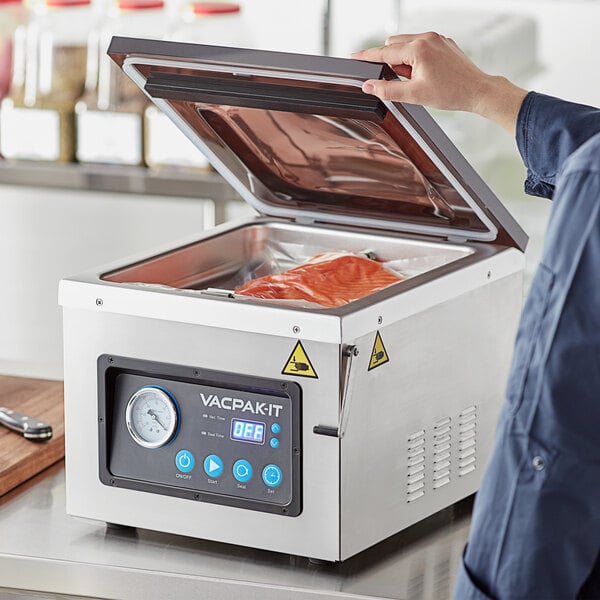Chamber Vacuum Sealers
In the world of packaging, efficiency, reliability, and preservation are paramount. Chamber vacuum sealers are at the forefront of advanced packaging technology, offering unparalleled sealing capabilities for a wide range of products. Whether you’re a commercial food processor, a culinary enthusiast, or a manufacturer, understanding the ins and outs of chamber vacuum sealers can revolutionize your packaging process. This comprehensive guide covers everything you need to know about chamber vacuum sealers.
What is a Chamber Vacuum Sealer?
A chamber vacuum sealer is a sophisticated packaging machine designed to remove air from the packaging chamber before sealing. Unlike external vacuum sealers, which draw air out of the bag, chamber vacuum sealers remove air from the entire chamber, allowing for efficient sealing of liquids, powders, and other moisture-rich products. These machines are commonly used in commercial kitchens, food processing facilities, and industrial manufacturing settings.

How Does a Chamber Vacuum Sealer Work?
- Product Placement: The product to be sealed is placed inside the vacuum chamber along with the packaging material.
- Air Removal: The chamber is sealed, and a vacuum pump removes air from the chamber, including air from inside the packaging material.
- Sealing Process: Once the desired level of vacuum is achieved, the sealing bar heats and seals the packaging material, creating an airtight seal.
- Release of Vacuum: The vacuum is released from the chamber, and the sealed package is removed.

Key Features of Chamber Vacuum Sealers
- Chamber Design: Allows for the removal of air from both the product and the packaging material, enabling efficient sealing of liquids and powders.
- Adjustable Vacuum Levels: Provides control over the level of vacuum applied, accommodating different products and packaging requirements.
- Sealing Bar Options: Available with single or multiple sealing bars for increased productivity and versatility.
- Gas Flush Option: Some models offer gas flushing capabilities to replace the removed air with inert gas, extending the shelf life of the product.
- Durable Construction: Made with high-quality materials to withstand heavy-duty use in commercial environments.
Applications of Chamber Vacuum Sealers
- Food Preservation: Extends the shelf life of perishable foods such as meats, cheeses, and vegetables by removing air and sealing in freshness.
- Marinating: Infuses flavors into foods quickly by creating a vacuum environment that opens up pores in the food.
- Industrial Packaging: Seals sensitive electronic components, medical devices, and other products to protect them from moisture and contaminants.
- Bulk Packaging: Efficiently packages large quantities of products such as grains, powders, and liquids for storage or distribution.
- Retail Packaging: Creates tamper-evident packaging for consumer goods, ensuring product integrity and safety.
Benefits of Using Chamber Vacuum Sealers
- Preservation of Freshness: Removes air to prevent oxidation and spoilage, preserving the quality and flavor of products.
- Enhanced Food Safety: Creates a barrier against bacteria and contaminants, reducing the risk of foodborne illnesses.
- Versatility: Accommodates a wide range of products and packaging materials, including pouches, jars, and containers.
- Increased Efficiency: Streamlines the packaging process, allowing for rapid sealing of multiple products.
- Cost Savings: Reduces food waste and extends product shelf life, leading to lower operational costs.
How to Choose the Right Chamber Vacuum Sealer
When selecting a chamber vacuum sealer, consider the following factors:
- Chamber Size: Choose a machine with a chamber size that accommodates your largest products.
- Vacuum Pump Capacity: Select a vacuum sealer with a pump that meets your production volume requirements.
- Sealing Bar Configuration: Determine whether a single or multiple sealing bars are needed based on your packaging needs.
- Gas Flush Option: If gas flushing is required, ensure the machine offers this feature.
- Build Quality: Invest in a machine with durable construction and reliable components for long-term use.
Maintenance and Care Tips
- Regular Cleaning: Clean the vacuum chamber and sealing bar regularly to prevent residue build-up and ensure optimal sealing performance.
- Oil Change: If the vacuum pump is oil-based, follow the manufacturer’s recommendations for oil changes to maintain pump efficiency.
- Sealing Bar Inspection: Check the sealing bar for wear and damage, and replace it as needed to maintain airtight seals.
- Vacuum Chamber Inspection: Periodically inspect the vacuum chamber for any signs of damage or wear, and address any issues promptly.
- Calibration: Calibrate the vacuum level and sealing temperature as needed to ensure consistent results.
Conclusion
Chamber vacuum sealers are indispensable tools for businesses that require efficient, reliable, and versatile packaging solutions. Their ability to remove air from both the product and the packaging material sets them apart from other sealing methods, making them ideal for a wide range of applications. By understanding their functionality, features, and maintenance requirements, you can leverage chamber vacuum sealers to enhance your packaging operations, improve product quality, and reduce waste.
Investing in a high-quality chamber vacuum sealer can transform your packaging process, offering precision, efficiency, and consistency that meet the demands of modern production environments. Whether you’re sealing food products, industrial components, or consumer goods, these machines provide a robust solution to keep your items securely packaged and preserved.

